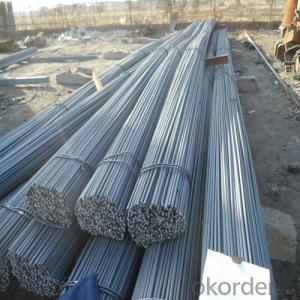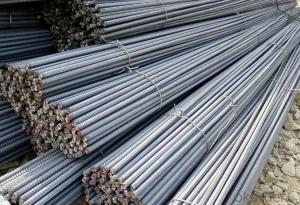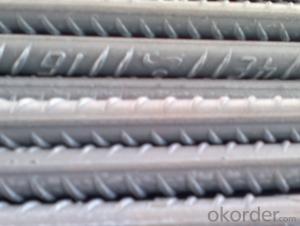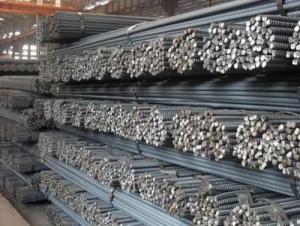Deformed Steel Bar Reinforced Deformed Steel Bar HRB400
- Loading Port:
- Tianjin
- Payment Terms:
- TT or LC
- Min Order Qty:
- 50 m.t.
- Supply Capability:
- 50000 m.t./month
OKorder Service Pledge
OKorder Financial Service
You Might Also Like
Product Description:
OKorder is offeringDeformed Steel Bar Reinforced Deformed Steel Bar HRB400 at great prices with worldwide shipping. Our supplier is a world-class manufacturer of steel, with our products utilized the world over. OKorder annually supplies products to European, North American and Asian markets. We provide quotations within 24 hours of receiving an inquiry and guarantee competitive prices.
Product Applications:
Deformed Steel Bar Reinforced Deformed Steel Bar HRB400 are ideal for structural applications and are widely used in the construction of buildings and bridges, and the manufacturing, petrochemical, and transportation industries.
Product Advantages:
OKorder's Deformed Steel Bar Reinforced Deformed Steel Bar HRB400 are durable, strong, and resist corrosion.
Main Product Features:
· Premium quality
· Prompt delivery & seaworthy packing (30 days after receiving deposit)
· Corrosion resistance
· Can be recycled and reused
· Mill test certification
· Professional Service
· Competitive pricing
Product Specifications:
Standard | GB | HRB400 | |
Diameter | 6mm,8mm,10mm,12mm,14mm,16mm,18mm,20mm, 22mm,25mm,28mm,32mm,36mm,40mm,50mm | ||
Length | 6M, 9M,12M or as required | ||
Place of origin | Hebei, China mainland | ||
Advantages | exact size, regular package, chemical and mechanical properties are stable. | ||
Type | Hot rolled deformed steel bar | ||
Brand name | DRAGON | ||
Chemical Composition: (Please kindly find our chemistry of our material based on HRB500 as below for your information)
Grade | Technical data of the original chemical composition (%) | ||||||
C | Mn | Si | S | P | V | ||
HRB400 | ≤0.25 | ≤1.60 | ≤0.80 | ≤0.045 | ≤0.045 | 0.04-0.12 | |
Physical capability | |||||||
Yield Strength (N/cm²) | Tensile Strength (N/cm²) | Elongation (%) | |||||
≥400 | ≥570 | ≥14 | |||||
Theoretical weight and section area of each diameter as below for your information:
Diameter(mm) | Section area (mm²) | Mass(kg/m) | Weight of 12m bar(kg) |
6 | 28.27 | 0.222 | 2.664 |
8 | 50.27 | 0.395 | 4.74 |
10 | 78.54 | 0.617 | 7.404 |
12 | 113.1 | 0.888 | 10.656 |
14 | 153.9 | 1.21 | 14.52 |
16 | 201.1 | 1.58 | 18.96 |
18 | 254.5 | 2.00 | 24 |
20 | 314.2 | 2.47 | 29.64 |
22 | 380.1 | 2.98 | 35.76 |
25 | 490.9 | 3.85 | 46.2 |
28 | 615.8 | 4.83 | 57.96 |
32 | 804.2 | 6.31 | 75.72 |
36 | 1018 | 7.99 | 98.88 |
40 | 1257 | 9.87 | 118.44 |
50 | 1964 | 15.42 | 185.04 |
Usage and Applications of HRB400 Deformed Steel Bar:
Deformed bar is widely used in buildings, bridges, roads and other engineering construction. Big to highways, railways, bridges, culverts, tunnels, public facilities such as flood control, dam, small to housing construction, beam, column, wall and the foundation of the plate, deformed bar is an integral structure material. With the development of world economy and the vigorous development of infrastructure construction, real estate, the demand for deformed bar will be larger and larger..
Packaging & Delivery of HRB400 Deformed Steel Bar:
Packaging Detail: products are packed in bundle and then shipped by container or bulk vessel, deformed bar is usually naked strapping delivery, when storing, please pay attention to moisture proof. The performance of rust will produce adverse effect.
Each bundle weight: 2-3MT, or as required
Payment term: TT or L/C
Delivery Detail: within 45 days after received advanced payment or LC.
Label: to be specified by customer, generally, each bundle has 1-2 labels
Trade terms: FOB, CFR, CIF
FAQ:
Q1: Why buy Materials & Equipment from OKorder.com?
A1: All products offered byOKorder.com are carefully selected from China's most reliable manufacturing enterprises. Through its ISO certifications, OKorder.com adheres to the highest standards and a commitment to supply chain safety and customer satisfaction.
Q2: How do we guarantee the quality of our products?
A2: We have established an advanced quality management system which conducts strict quality tests at every step, from raw materials to the final product. At the same time, we provide extensive follow-up service assurances as required.
Q3: How soon can we receive the product after purchase?
A3: Within three days of placing an order, we will begin production. The specific shipping date is dependent upon international and government factors, but is typically 7 to 10 workdays.
Images:
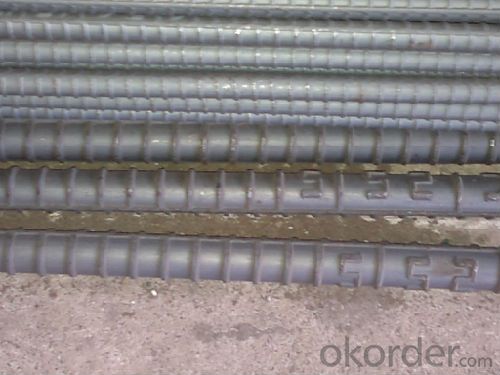
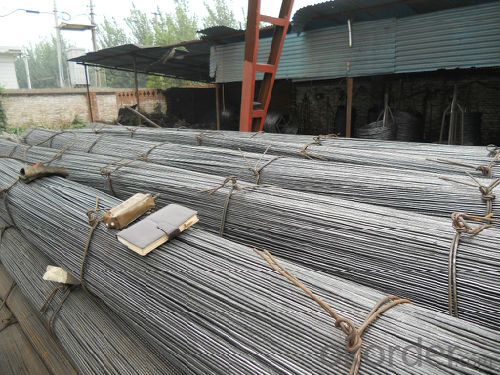

- Q:Are steel rebars cost-effective?
- Steel rebars are generally considered to be a cost-effective option. They are extensively used in construction projects to reinforce concrete structures because they offer numerous advantages. Firstly, steel rebars possess a high tensile strength that enables them to withstand heavy loads and prevent concrete from cracking or collapsing under stress. This durability ensures the stability of the reinforced structure, reducing the need for frequent repairs or replacements and ultimately saving on maintenance costs. Furthermore, steel rebars are readily available in the market, making them a cost-effective choice for construction projects. Their production is well-established and efficient, resulting in competitive prices. Moreover, steel is a recyclable material, allowing rebars to be easily reused or recycled at the end of their lifespan. This contributes to sustainability and reduces the overall cost of construction materials. Additionally, steel rebars offer versatility in design and construction. They can be easily shaped and customized to meet specific project requirements, making them suitable for a wide range of applications. This flexibility eliminates the need for expensive and time-consuming alternatives, saving both time and money during the construction process. However, it is crucial to consider the specific project requirements and local market conditions when assessing the cost-effectiveness of steel rebars. Factors such as project size, labor costs, and the availability of alternative reinforcement materials can impact the overall cost. Depending on the project specifications and local market conditions, alternative materials like fiber-reinforced polymers (FRP) or glass fiber-reinforced polymers (GFRP) may prove to be more cost-effective. In conclusion, steel rebars are widely acknowledged for their cost-effectiveness due to their durability, availability, recyclability, and versatility. Nevertheless, conducting a comprehensive cost analysis that considers specific project requirements and available alternatives is essential to make an informed decision.
- Q:Are there any limitations on the maximum number of steel rebars that can be used in a concrete element?
- Yes, there are limitations on the maximum number of steel rebars that can be used in a concrete element. These limitations are usually specified by building codes, structural design standards, and engineering principles. The maximum number of rebars is determined by factors such as the size and dimensions of the concrete element, the load it needs to support, and the required spacing and arrangement of rebars to ensure proper reinforcement and structural integrity.
- Q:What are the different types of coatings available for protecting steel rebars?
- There are several types of coatings available for protecting steel rebars, including epoxy coatings, polyethylene encasement, zinc coatings, and fusion-bonded epoxy coatings. These coatings provide different levels of protection against corrosion, ensuring the longevity and durability of the steel rebars in various environments.
- Q:How do steel rebars affect the cost of a construction project?
- Several factors come into play when considering how steel rebars can affect the cost of a construction project. To start, reinforced concrete structures often rely on steel rebars for strength and stability. The specific quantity and quality of rebars necessary for a project depend on factors like the structure's size, design, and intended use. The cost of steel rebars is a significant factor to consider. Fluctuations in market conditions, availability, and demand can cause the price of steel rebars to vary, which can have a substantial impact on the overall project cost. Additionally, the grade and quality of rebars can also differ, with higher grades typically being more expensive. Moreover, the quantity of rebars needed directly influences the cost. Large-scale projects that require a significant amount of rebars, such as high-rise buildings or infrastructure projects, can incur considerable expenses related to rebars. The cost is influenced by factors like the structure's size, complexity, and the engineering and design requirements. Labor costs associated with handling, cutting, bending, and placing rebars are another critical consideration. Skilled labor is necessary to ensure proper installation, correct positioning, and securement of rebars. The more complex the structure or design, the more labor-intensive and time-consuming the rebar installation becomes, resulting in higher labor costs. In addition, the use of rebars can impact project scheduling and timelines. Additional time may be required for procuring, delivering, and installing rebars, potentially leading to delays in the overall construction schedule. Any delays can result in increased project costs due to extended labor and overhead expenses. Lastly, it is crucial to consider the long-term cost implications of using rebars. Steel rebars provide durability and strength to concrete structures, which can lead to reduced maintenance and repair costs over the project's lifespan. Investing in high-quality rebars from the start can save money in the long run by minimizing the need for future repairs or replacements. In conclusion, the use of steel rebars has a significant impact on the cost of a construction project. The cost of rebars themselves, the quantity required, labor expenses, project scheduling, and long-term durability considerations all contribute to the overall impact on project cost. Construction professionals must carefully analyze and plan for these factors to ensure accurate cost estimations and successful project execution.
- Q:How do steel rebars affect the crack width in reinforced concrete?
- Controlling and minimizing crack width in reinforced concrete structures is a crucial role played by steel rebars. Tensile strength is the primary function of steel rebars, as concrete alone is weak in tension. When a load is applied to reinforced concrete, the steel rebars resist the tensile forces and prevent cracks from widening. The presence of steel rebars helps evenly distribute stress and strain throughout the concrete, which confines and limits the width of cracks that may occur due to external loads or shrinkage. The rebars act as reinforcement, inhibiting crack propagation and reducing crack width. This is especially important in structural elements like beams and columns, where crack control is critical to maintaining structural integrity and durability. The crack width in reinforced concrete is also influenced by the diameter, spacing, and arrangement of rebars. Properly designed and placed rebars provide optimal crack control. As the diameter and spacing of rebars decrease, the crack width also decreases. Additionally, using a specific pattern for rebar arrangement, such as a mesh or grid, can further enhance crack control by offering additional resistance to crack propagation. Furthermore, the bond between steel rebars and concrete is essential for crack width control. Adequate bond strength ensures effective stress transfer from rebars to concrete, which limits crack width. Insufficient bond can result in slip between rebars and concrete, allowing cracks to widen. In conclusion, steel rebars have a significant impact on crack width in reinforced concrete by providing tensile strength, distributing stress and strain, confining cracks, and enhancing the bond between steel and concrete. Proper design, placement, and arrangement of rebars are crucial for effective crack control, ultimately improving the overall performance and longevity of reinforced concrete structures.
- Q:How are steel rebars protected against alkali attacks?
- Steel rebars are protected against alkali attacks by applying a protective coating or by using corrosion-resistant materials such as stainless steel rebars. Additionally, proper concrete mix design, including the use of low alkali cement and supplementary cementitious materials, can help mitigate alkali attacks on steel rebars.
- Q:What is the process of deforming steel rebars for better adhesion with concrete?
- The process of deforming steel rebars for better adhesion with concrete is known as ribbing or rib formation. It involves creating a series of ribs or deformations along the surface of the rebars to increase their surface area and improve the bond strength between the steel and concrete. This is typically achieved by passing the rebars through a specialized machine that uses rollers or dies to shape the desired rib pattern. The resulting ribbed rebars provide enhanced mechanical interlocking with the concrete, ensuring a stronger and more durable bond in reinforced concrete structures.
- Q:What is the difference between rebar bolts and steel bars?
- Rebar is only material, and thread steel bolt is the product after the thread steel is processed.
- Q:Can steel rebars be used in the construction of dams or reservoirs?
- Yes, steel rebars can be used in the construction of dams or reservoirs. Steel rebars are commonly used as reinforcement in concrete structures, including dams and reservoirs, to provide strength and stability. They help to distribute and resist the tensile forces that can occur in these structures due to water pressure and other external loads. Steel rebars are corrosion-resistant, durable, and have high tensile strength, making them an ideal choice for such applications. Additionally, they can be easily shaped and installed, providing flexibility in the design and construction process.
- Q:What is the recommended spacing between horizontal steel rebars in beams?
- The recommended spacing between horizontal steel rebars in beams typically depends on various factors such as the design requirements, load conditions, and the size of the beam. Generally, the spacing between rebars in beams ranges from 2 to 6 inches. However, it is crucial to consult with a structural engineer or refer to the applicable building codes and standards to determine the specific recommended spacing for a particular beam design.
1. Manufacturer Overview |
|
|---|---|
| Location | |
| Year Established | |
| Annual Output Value | |
| Main Markets | |
| Company Certifications | |
2. Manufacturer Certificates |
|
|---|---|
| a) Certification Name | |
| Range | |
| Reference | |
| Validity Period | |
3. Manufacturer Capability |
|
|---|---|
| a)Trade Capacity | |
| Nearest Port | |
| Export Percentage | |
| No.of Employees in Trade Department | |
| Language Spoken: | |
| b)Factory Information | |
| Factory Size: | |
| No. of Production Lines | |
| Contract Manufacturing | |
| Product Price Range | |
Send your message to us
Deformed Steel Bar Reinforced Deformed Steel Bar HRB400
- Loading Port:
- Tianjin
- Payment Terms:
- TT or LC
- Min Order Qty:
- 50 m.t.
- Supply Capability:
- 50000 m.t./month
OKorder Service Pledge
OKorder Financial Service
Similar products
New products
Hot products
Hot Searches
Related keywords
